Red rabbits with red eyes - Lutino and Shadow
Beschreibung: The pink eyed dilution factor on rabbits
Kategorie: Farben, Genetik, Vererbung & Co.
Link zu diesem Beitrag: Alles auswählen
[url=https://www.kaninchenwissen.de/kb/viewarticle?a=34&sid=5c6f6cea21ae5e5de4edb0ebc0a8fe4e]Knowledge Base - Red rabbits with red eyes - Lutino and Shadow[/url]
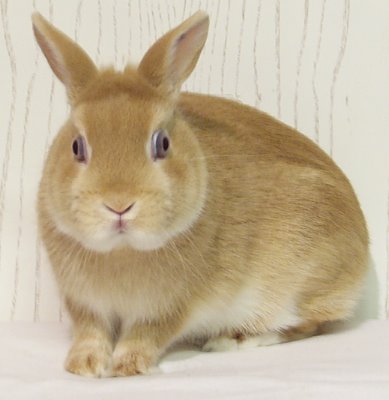
Yes, you listened right: red eyes in a non-albino.
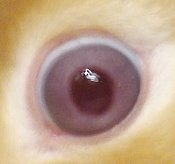
The History
The first fawn rabbit with red eyes was found 1985 in a litter of japanese dwarfs by the Danish breeder Gerner Rasmussen. He dont culled them, but kept them and repeated this pairing. In a 3rd litter he again found an animal with red eyes. The offspring of these animals formed the basis of a new breed. Dwarfs in the colors Lutino and Shadow were recognised in the Scandinavian standard in October 1988.
Lutino has yellow to orange coat color. Undercolor, belly and agouti markings are creamy or white, eyes red.
Shadow has creamy yellowish coat color with light blue parts. Undercolor is light blue, even lighter to the skin. Belly and agouti markings are creamy or white, eyes red with a weak blue iris.
New mutations, moreover the "usable" ones, are not so common. The most recent mutations found in rabbits was the light chinchilla factor in 1924 and the satin factor in 1930. If you consider the lutino factor was first found in rabbits more than 20 years ago, it's surprising, that he is so completely unknown.
The Lutino factor
Searching for a factor causing red eyes and heavily dilutes dark pigment inevitably leads to the factor "red eyed dilution." This factor is known for a long time in the mouse (the best investigated mammal) and other rodents. In people it causes a form of oculocutaneous albinism (OCA 2).
The factor is symbolizes with p.
Silvers wrote in "The Coat Colors of Mice" about the allele p:
The eyes of p/p mice resemble those of albinos, possessing a beautiful pink tint. However, in contrast to albino eyes, p/p eyes are not completely free of pigment; small amounts of melanin are found in the iris and retina (Durham, 1908, 1911; Little, 1913) and a few melanocytes occur in the choroid as well (Markert and Silvers, 1956).
Insofar as it concerns the pigmentation of the hair, p drastically reduces black and brown pigments, but has only a slight influence on phaeomelanin synthesis.
Thus, except for the color of the eyes, the yellow versions with and without p/p looks much alike. Agouti pink-eyed animals also superficially resemble orange or yellow animals although they possess dull or slate grey hair bases which are recognized most readily when the hair is blown.
Colors with p/p resemble the diluted colors blue and lilac, but are lighter.

On looking at lutinos we accordingly see, they look like normal, yellow/red agoutis with red eyes. Their gene code is ABCDee pp. The purity of color benefit from the Lutino-Faktor who heavily lighten the dark pigment and let possible smut disappear.
The Shadow (picture right) looks very similar, but is still lighter. I can't really find the "lightblue" underolor, they is just very light, almost white. The Shadow in the photo is a combination of steel/red (Es/e, this would look like solid black without pp).
Naming

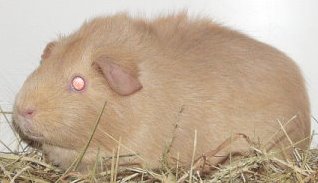
For comparison, a mouse and a guinea pig (with flash eyes) with the gene code ABCDE p.
In Norway a few breeders are working on other color varietys. There is an attempt to breed a "true" red rabbit with red eyes, the Rubino. (The name was taken over from the red birds with red eyes.)
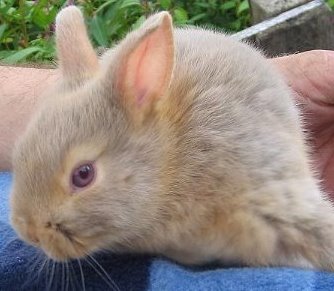
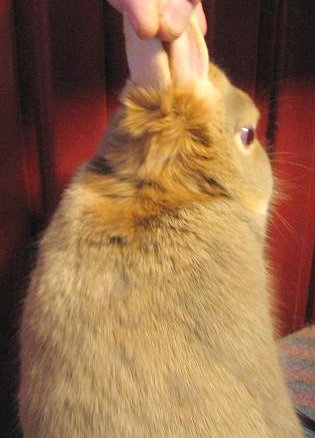
Whether this is true, one can easily find out theoretically. One need simply to add the Chinchilla factor. Practically it is a bit difficult. Take a Shadow ABCDE p and breed him to a Silver Fox AtBcchdDE P. Now, breeding siblings together, we "only" need to get cchd, at and p together in one rabbit. With 3 factors, we have a chance of 1:64.
Colors and mice
dove (black tan + lutino

silver (blue tan + lutino)

champagne (chocolate tan + lutino)

lavender (lilac + lutino)

Ok, yellow/red or lilac rabbits are not sooo special, even if they have different colored eyes. But the lutino factor could also allow color shades who not exist yet in rabbits. 
silver (blue tan + lutino)

champagne (chocolate tan + lutino)

lavender (lilac + lutino)

Mice, for example, come, beside dove (red eyed dilution black based), in silver and champagne. These are the combinations from lutino with blue or chocolate. With lilac its named lavender and then apparently looks almost white.
Champagne looks nice, such a bright, smooth cream. But currently it looks like all pp rabbits become more or few yellowish, because the rabbits have more yellow pigment under the dark one, so this colors are, if anyhow, only able as chin variant.
http://www.rabbitcolors.info/int/en/entries/p/1.html - Images of Rabbits with lutino factor on rabbitcolors.info
Mice pics, by courtesy of [url=http://www.crazzyhmousery.homestead.com]Timiae[/url]
Lohlutinofoto, by courtesy of Sølvi Lysfjord
used literature:
http://www.dvaergkanin.dk/lutino.htm,
http://home.online.no/~geinordv ,
http://www.informatics.jax.org/wksilvers
Normal Tyrosine Transport and Abnormal Tyrosinase Routing in Pink-Eyed Dilution Melanocytes; S. Brian Potterf, Minao Furumura, Elena V. Sviderskaya,Chie Santis, Dorothy C. Bennett, and Vincent J. Hearing; EXPERIMENTAL CELL RESEARCH 244, 319-326 (1998)
The Pink-eyed Dilution Locus Controls the Biogenesis of Melanosomes and Levels of Melanosomal Proteins in the Eye, SETH J. ORLOW, and MURRAY H. BRILLIANT, Exp. Eye Res. 68, 147-154 (1999)